Just imagine for a moment that you have a fight with your landlord. Perhaps he is unreasonably raising your rent. Or perhaps he expects you to pay for certain defects in the property which you are not responsible for. Whatever the scenario may be, let’s imagine for a moment that you and your landlord have a dispute and it escalates to legal proceedings. You file a small claim for US$5,000 and expect to meet with a lawyer or plead your case before a judge. This might be true in almost every county and country in the world–except Estonia.
Over the course of 2019, the Estonian Ministry of Justice, in conjunction with Estonia’s Chief Data Officer Ott Velsberg, have developed and piloted an artificial intelligence (AI) software to hear and decide on small claims disputes less than €7,000. The program is still just starting out and could potentially be the very beginning of a global wave of AI in the judiciary, but before all that happens, we must consider our past with integrating technology and the judiciary and carefully weigh the pros and cons. Ultimately, Velsberg wants to “eliminate the human element.”
Although this sounds frighteningly similar to images evoked in Brave New World, 1984, and other dystopian science fiction stories, automation has already been integrated into the judiciary. For example, across the world, digital cameras and software have completely replaced any and all need for human interactions with the police or judge in relation to traffic offences, such as speeding or running red lights. Should you exceed the speed limit, a camera simply takes a photo of your license plate, which links to your name, address, and registration information to forward you a fine, whose amount is predetermined. While that might have been met with hostility upon introduction, they populate roads all across the world without much notice or remark.
But of course, this is still very different from Estonia’s proposal of an AI judge. AI differentiates itself from machine automation through a slightly perverse sense of self-thinking and self-growing–the very characteristics that we humans use to differentiate ourselves from machines. By definition, humans possess skills that machines cannot; in the case of the judiciary, it is the ability to critically analyse a situation and be sufficiently flexible to decide on fair judgments while adapting to a range of scenarios and consideration factors. A simple input and output would be okay, but a thinking, analyzing entity? That sounds extreme.

Introduction of AI in the Judiciary
Even before Estonia took the first deep dive into a “robot judge,” other countries have slowly progressed their automation into AI. Taking the automated traffic fines example, Australia has expanded the system by implementing cameras supplemented with AI technology that look through your windscreen and analyse whether the driver is on their phone–a world first. Perhaps this was not quite the AI integration into justice that the science fiction stories made it out to be, but it was still met with an initial sense of unease. Nevertheless, the system has now largely been accepted as the norm.
AI has been expanding into the judiciary, not just in the field of law enforcement but also in the previously-exclusive field of litigation. In 2014, a chatbot lawyer, called DoNotPay, carved out a niche for itself in being the world’s first AI lawyer. It had a very simple goal, which was to appeal parking tickets in the city of London. DoNotPay performed this bureaucratic task, usually a job lawyers charge for, for free. Over the course of the first 21 months since its inception, it worked on 250,000 cases and won 160,000 of them. It is not a perfect score, but over US$4 million in overturned parking fines for an AI lawyer is impressive indeed. Although software like DoNotPay has a long way to go, its accuracy and effectiveness even in its early stages of development shows that even the legal profession is prone to AI encroachment.
Permeating into all aspects of the litigation sphere, select cities and provinces in China, like Hangzhou, have also developed an AI judge in a cyber court setting, much like the model presented by Estonia. It was only in December 2019, that China’s highest court, the Supreme People’s Court, revealed that they had been using an AI judge. In fact, they had been using the cyber court system since 2017. This “Internet Court” engages with matters that involve the digital world to some respect, such as e-commerce disputes and copyright.
China’s cyber court holds two key distinctions from Estonia’s more radical change. First, the system is not government facilitated. Rather than Estonia’s official government channels, China’s court occurs as a function on WeChat, China’s predominant social media platform and a private company. So despite the formal sounding title, it is more akin to alternative dispute resolution like mediation. Second, as a consequence of being a non-government feature, it is an opt-in system. Users must mutually agree to take the case up to the AI judge, but they can still pursue the traditional routes should they prefer.
Estonia, a small European country with just 1.3 million citizens, is by far the world’s biggest change when it comes to integrating AI with the judiciary; it will take over the small claims dispute resolution. This project is aided by the fact that Estonia has exponentially integrated with technology, with nation-wide ID cards and the vast majority of Estonians filing government documents online. Small claims often hamper judges from working on bigger, more important matters, and the cases create huge backlogs both for those needing to deliver justice and those seeking compensation. Estonia’s Ministry of Justice hopes to solve all that with this new initiative.

Benefits of an AI Judiciary
For the Estonian and Chinese governments, the benefits are clear. AI judges are faster, they can process multiple cases at the one time, and they can find relevant legal documents almost instantly. Not only is this beneficial for the judges to focus on more important rulings, it is also helpful for the citizens who do not want to be caught up in the lengthy, expensive, and stressful litigation process.
AI judges also have the potential to be fairer than human judges. A joint study between Australia’s Swinburne University Law School and Queensland University of Technology found that courts in the status quo were influenced by arbitrary factors like race or socioeconomic status. Moreover, because the judiciary as a collective body is composed of hundreds, if not thousands, of different judges, lawyers, and legal professionals, judgments were inconsistent across different courts. To illustrate, the study found that one court in Victoria, Australia’s second most populous state, was three times more likely to imprison offenders than other courts in the state. One centralized, consistent judge would be the logical solution, a physically impossible feat until now, with the development of AI.
Moreover, in the particular case of AI lawyers as in the United Kingdom, legal representation and just recourse has become much more accessible. The biggest criticisms of the legal system are that it is too expensive to hire a lawyer and that many are not aware of their options. A digital system allows individuals to access legal services for free and in their own time, meaning that the low and middle class can navigate any legal disputes for free. Justice is served without anyone sacrificing a work day or paycheck.

Dangers of an AI Judiciary
But like with any technological innovation, the potential for hacking proposes a substantial risk. This is particularly important when concerned with legal matters. Although the systems presently do not involve high stakes cases such as criminal trials, the courts have the potential to save or ruin lives, build or cripple companies, and set incredibly significant social precedents whose effects flow on for centuries. Already, the world has seen the impact of hacking into other branches of government through cases like electoral interference, and more technological integration into the judiciary is an invitation for vulnerability.
Moreover, because AI relies on having a vast database of past cases to then predict judgments for future cases, AI judges would recreate the past mistakes and implicit prejudices of past cases overseen by humans into perpetuity. AI does not have the capacity to adapt flexibly with the social mores of the time or recalibrate based on past errors. And when the courts become social barometers, it is imperative that the judges are not informed solely by the past.
Questions for the Future
The arc of the judiciary towards AI integration has been an exceptionally long one, and it will probably extend even further. This is a good thing: the court system is one of the most impactful institutions in the world, and is steeped in deep tradition and history. Any new step must be taken with extreme caution to be sure that it is indeed a step in the right direction.
On one hand, AI promises efficiency, consistency, and accessibility. On the other, it risks vulnerability to external influence and propagation of past injustices. Should justice be compromised for speed? What role does human interaction play in the justice system? Is an unemotional, purely consistent arbitrator even a good thing? How does technology grow with the times? Going forward, legislators and innovators alike must grapple with these big questions.






